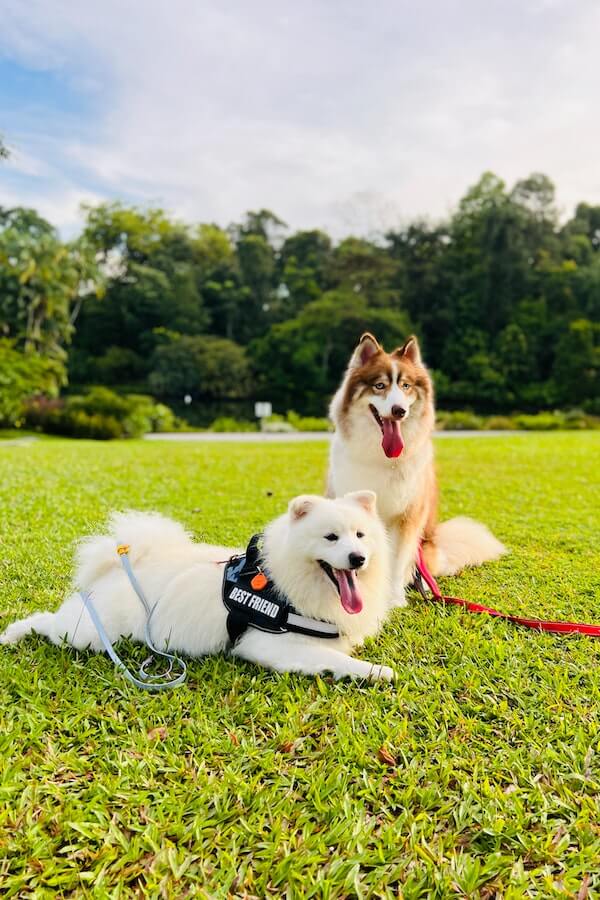
Are you tired of your dog being aggressive to other animals or pets? Does it seem like nothing can make them stop?
Well, don’t worry – there are a few simple steps that you can take to help get your pup back on the path of peace and harmony.
Here we will discuss the basics of how to get a dog to stop being aggressive towards other pets.
With patience and practice, you can help your pooch become the best canine companions they can be!
Why do dogs get aggressive toward other pets
It’s a fact of life that dogs can be pretty territorial when it comes to other animals.
That doesn’t mean they can’t get along, but it does mean they might need a little help from their owners to do so.
Here are three reasons why dogs may become aggressive towards other pets:
1. Fear
Your dog may feel threatened by another pet, especially if the animal is larger than them or unfamiliar.
Dogs that have had traumatic experiences with other animals in the past may also act out aggressively toward new ones as a way to protect themselves.
2. Lack of Socialization
Just like humans, dogs need socialization in order to learn how to interact and get along with others.
If your pup hasn’t had enough opportunities to interact with other animals, they may become aggressive as a way to express their discomfort.
3. Territoriality
Dogs can be very possessive when it comes to the people and places that are important to them, so if they feel like another animal is intruding on their turf, they might lash out as a warning.
Signs of aggression in dogs toward other pets

If your pup is showing the following signs, it’s likely they’re feeling uncomfortable or threatened by another pet:
1. Barking
If your dog starts barking uncontrollably at other animals, they may be displaying aggression.
2. Growling
Dogs will often growl if they feel threatened or uncomfortable by another pet’s presence.
3. Biting
While this is a more serious sign of aggression, it’s still something to look out for when assessing the situation.
4. Showing Teeth
If your pup displays their teeth even slightly, that could mean they are feeling aggressive and territorial towards another pet in the room.
5. Posture
Pay attention to your dog’s body language as well- if their tail is tucked between their legs, ears pinned back and hair standing up, they may be feeling very uncomfortable and ready to attack.
How to get a dog to stop being aggressive towards other pets

If your pup has been a bit too pawsy with other pets, it’s time to get them on the path of good pet citizenship! Here are five tips for training your dog to be less aggressive towards other animals.
1. Socialize
Get your dog used to being around other animals by introducing them one at a time in a calm and controlled setting.
Make sure that the animal is also calm and well-behaved, as this will make it easier for your pup to get along with them.
2. Acknowledge their feelings:
Dogs can experience an array of emotions, so it’s important to acknowledge that they may feel scared or threatened by another pet.
This will help you better understand why they’re acting out and how to best handle the situation.
3. Establish boundaries:
Set some ground rules for when around other animals and make sure your pooch knows that any aggressive behavior is not allowed.
Both through verbal commands and physical cues like touching their muzzle or lifting them up.
4. Give your pup space:
Don’t force your dog to interact with other animals if they’re not comfortable doing so; instead, give them some space and let them decide when it’s time to approach the other pet.
5. Teach commands
If your pup does display aggressive behavior (such as barking or growling), immediately correct them with a firm “No!” command.
You can also use recall commands to bring back your pet to you.
Give your pup some space from the other pet and provide a distraction (such as a toy or treat) to help them focus their attention elsewhere.
6. Use rewards:
Positive reinforcement can go a long way! If your pup is behaving well around another animal, make sure to reward their good behavior with treats or lots of affection.
This will help reinforce the idea that being gentle is the way to go.
7. Practice makes perfect!
Be sure to consistently repeat the process of introducing your pup to other animals and providing positive reinforcement for good behavior.
Over time, this will help make your pup more comfortable being around other pets.
8. Ask the expert:
If you find that the aggressive behavior isn’t improving despite consistent training, consider seeking professional help from an animal behavior expert who can better assess your pup’s individual needs and develop a tailored training plan accordingly.
With these tips, your pup will be on its way to being the best-behaved pet in the neighborhood!
Are some dogs naturally more aggressive?

Aggression is a trait that can manifest differently in different breeds of dog.
Some dogs are naturally more prone to aggression than others, which may be related to the breed’s history and function.
To give you an idea of what canines to watch out for, here are five aggressive dog breeds:
1) Chihuahua
These pint-sized pooches can have powerhouse personalities! They often don’t get along well with strangers or other animals and can display protective behavior like excessive barking, if they feel threatened.
2) Pit Bull
Pit Bulls have been unfairly targeted as particularly dangerous over the years, but they certainly do not lack any strength when it comes to aggression.
That said, these dogs are highly loyal to their owners and won’t be aggressive if they are raised in a healthy, loving environment.
3) Rottweiler
Another misunderstood breed, Rottweilers can become incredibly territorial when it comes to protecting their family and property.
Training is essential for these powerful dogs and plenty of socialization helps too.
4) Dachshund
Don’t let this little pup’s size fool you; they can have a fierce temper that may surprise you! If pushed too far, these little sausages will show their teeth!
5) German Shepherd
Originally bred to herd sheep, the German Shepherd has many protective instincts making them great guard dogs.
However, if not treated with respect or not given enough exercise, these dogs can become aggressive.
Bottom Line

So the answer to How to get a dog to stop being aggressive towards other pets is proper training.
Along with that, patience and positive reinforcement are key when it comes to getting a dog to stop being aggressive towards other pets.
There are a few dog breeds that get along well with cats, so you can check them out if you need a calm dog for your home.
In the case of aggressive dogs, be sure to set boundaries and always reward good behavior. With enough time, you should be able to see improvement in your pup’s behavior.
Who knows – maybe one day they’ll even become best friends!
- 7 Dog Breeds With Webbed Feet And Why Do They Have Them - July 19, 2023
- 10 Best Fish For Small Tanks That Make Perfect Pets - July 18, 2023
- How to Breed Guinea Pigs: A Detailed Guide - July 17, 2023


GIPHY App Key not set. Please check settings